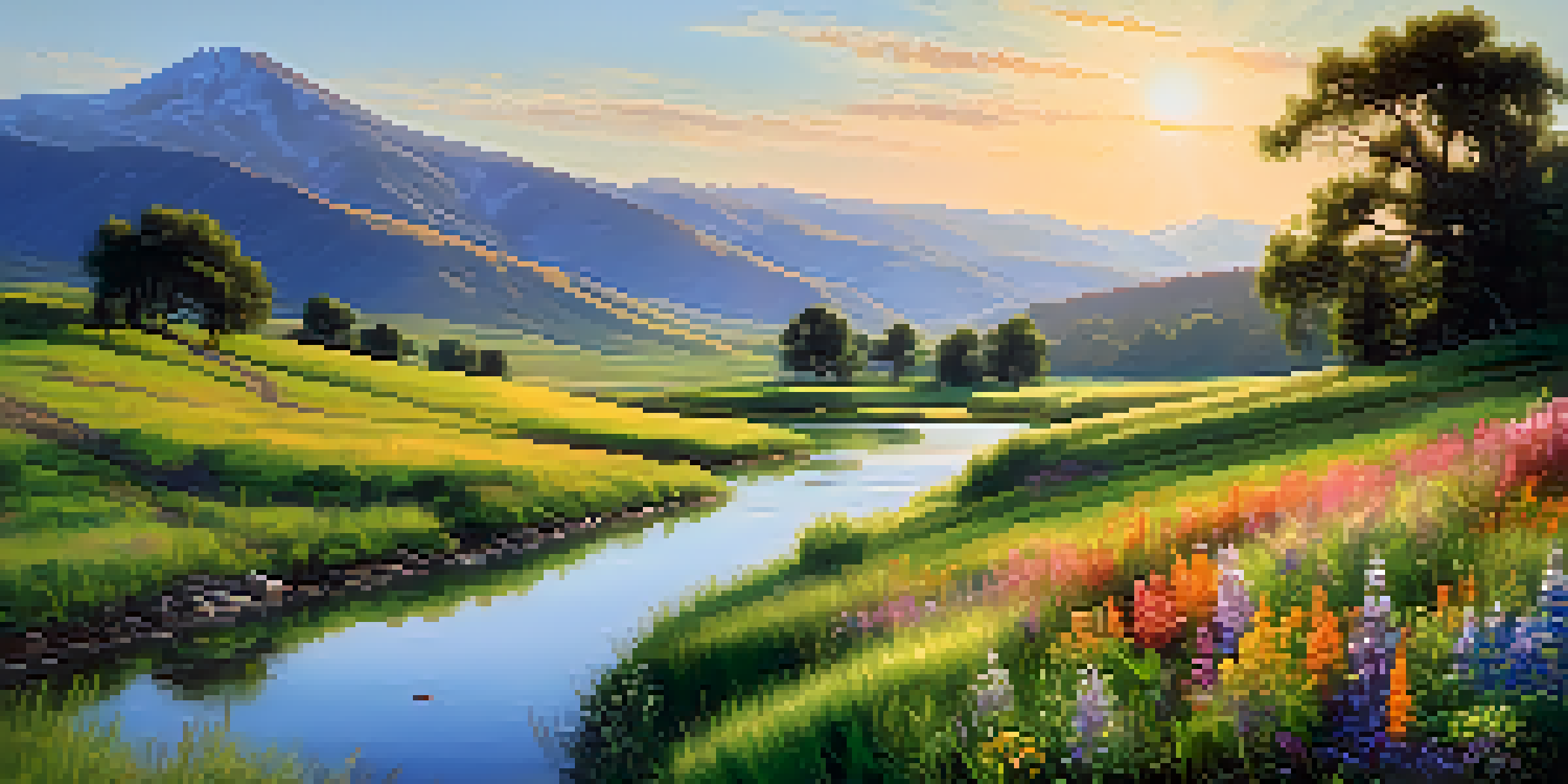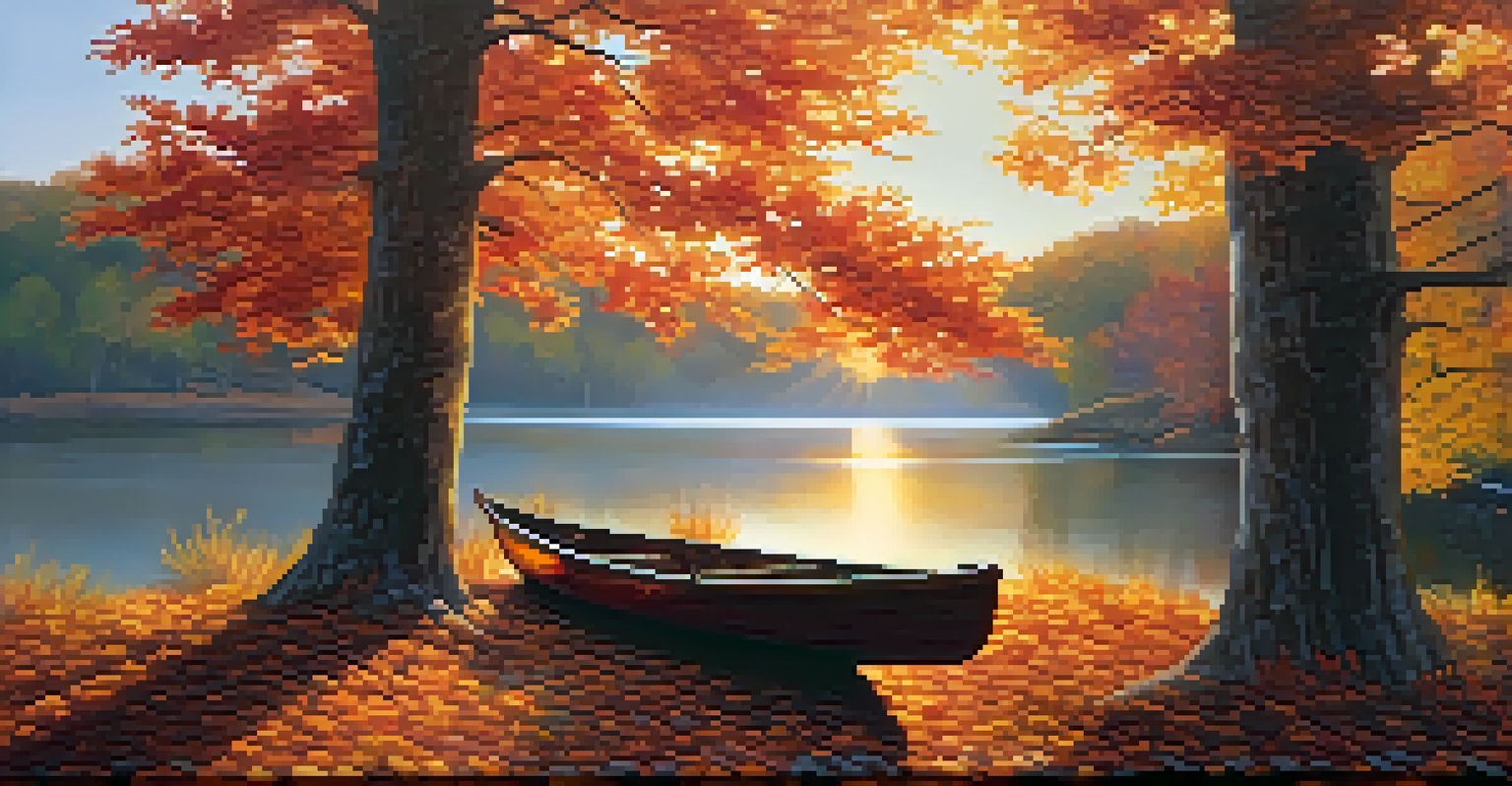Exploring the Foundations of Landscape Painting Techniques

Understanding the Basics of Landscape Painting
Landscape painting captures the beauty of nature, showcasing everything from rolling hills to serene lakes. This genre allows artists to express their connection to the environment while experimenting with light, color, and texture. Understanding the foundational concepts is crucial for anyone looking to create compelling landscapes.
The painter tries to master the light and shadow of nature, and thereby gives us a glimpse of the beauty that lies beyond our immediate perception.
At its core, landscape painting involves more than just mimicking what you see; it's about interpreting emotions and settings through your unique lens. Artists often start by studying the elements of design, such as composition and perspective, which help create a sense of depth. By grasping these basics, you can effectively communicate the essence of a scene.
Additionally, observing natural landscapes enhances your ability to paint them. Whether you're painting outdoors or from photographs, paying attention to how light changes throughout the day can inform your color choices and brush techniques. This initial exploration lays the groundwork for more advanced techniques.
The Role of Composition in Landscape Painting
Composition is like the backbone of a painting, guiding the viewer's eye and setting the overall mood. In landscape painting, effective composition helps create a dynamic balance between elements such as foreground, midground, and background. Artists often use techniques like the rule of thirds or leading lines to create visual interest.

For example, placing a prominent tree off-center can draw attention and lead the viewer's gaze deeper into the landscape. Additionally, incorporating elements like paths or rivers can create a natural flow throughout the painting. This careful arrangement not only enhances visual appeal but also tells a story.
Mastering Composition in Landscapes
Effective composition guides the viewer's eye and creates a dynamic balance in landscape paintings.
Moreover, experimenting with different compositions can lead to surprising discoveries. Don’t be afraid to reposition elements or try unconventional layouts, as this can help develop your unique style. Ultimately, a strong composition is essential for making your landscape painting resonate with viewers.
Color Theory and Its Importance in Landscapes
Color theory is a fundamental concept every artist should understand, especially in landscape painting. Colors evoke emotions and set the mood, allowing you to convey the atmosphere of a scene effectively. Understanding the color wheel, complementary colors, and color harmony can significantly enhance your work.
Nature is not a place to visit. It is home.
For instance, using warm colors like oranges and yellows can evoke feelings of warmth and sunshine, while cool colors like blues and greens can create a sense of calm and serenity. By mixing colors thoughtfully, you can also achieve naturalistic effects that mimic the variations found in nature. This attention to color can transform a simple landscape into a vibrant work of art.
Additionally, experimenting with color palettes can lead to exciting discoveries. Limiting your palette to a few colors can challenge you creatively and help you focus on the relationships between hues. This practice not only enhances your understanding of color but also encourages a more thoughtful approach to your landscape creations.
Mastering Light and Shadow in Landscapes
Light and shadow play a pivotal role in landscape painting, creating depth and dimension. Understanding how light interacts with various elements in a scene can dramatically influence the final outcome of your artwork. Observing the direction and intensity of light helps you determine where to place highlights and shadows.
For example, the golden hour, just before sunset, offers soft, warm light that beautifully illuminates landscapes. Capturing this quality of light can enhance the emotional impact of your painting. Conversely, understanding how to depict shadows can ground objects in your landscape, adding realism and dimensionality.
Understanding Color Theory
Color theory is essential for conveying emotions and setting the mood in landscape artwork.
Experimenting with different lighting conditions can also expand your skill set. Try painting the same scene at various times of the day to see how light transforms it. This practice not only improves your technical abilities but also deepens your appreciation for the nuances of nature.
Brush Techniques for Captivating Landscapes
The choice of brush techniques can significantly impact the texture and feel of a landscape painting. Different brushes create varied effects; for instance, flat brushes are ideal for broad strokes and smooth washes, while round brushes can add detail and precision. Understanding these tools empowers you to express your artistic vision effectively.
Incorporating techniques like glazing, scumbling, or dry brushing can add layers of depth and interest to your landscapes. For example, glazing involves applying thin layers of transparent color, creating luminosity that mimics sunlight filtering through leaves. Each technique serves a purpose and can be combined creatively to enhance your painting.
As with any skill, practice is essential. Experimenting with various brushes and techniques can lead to unique results, allowing you to discover what works best for your style. Over time, you'll develop a toolkit of techniques that can elevate your landscape paintings from ordinary to extraordinary.
Incorporating Nature: Plein Air Painting Techniques
Plein air painting, or painting outdoors, offers a unique way to connect with nature and capture its essence. This technique encourages artists to observe and respond to their environment in real-time, fostering a deeper understanding of light, color, and atmosphere. Many renowned landscape artists, such as Claude Monet, have embraced plein air painting, finding inspiration in the world around them.
When painting en plein air, it's essential to be prepared for changing conditions. Having a portable setup and materials ready can help you adapt quickly to shifting light and weather. This spontaneity can lead to unexpected and beautiful outcomes, as you're capturing a moment that may never occur again.
Exploring Plein Air Techniques
Plein air painting fosters a direct connection with nature and enhances observational skills.
Moreover, plein air painting can enhance your observational skills, as you're forced to notice details that might go unnoticed in a studio setting. This practice not only sharpens your technical abilities but also deepens your appreciation for the beauty of nature. By incorporating plein air techniques, you'll enrich your landscape painting experience.
Experimenting with Styles in Landscape Painting
Landscape painting encompasses a variety of styles, from realistic representations to abstract interpretations. Exploring different styles allows artists to discover their unique voice and push the boundaries of their creativity. Whether you're drawn to impressionism, realism, or abstract art, each style offers distinctive ways to portray landscapes.
For instance, an impressionistic style emphasizes capturing the moment's essence rather than focusing on detail. This approach can lead to vibrant, expressive works that evoke feelings and impressions of a scene, rather than a literal representation. Alternatively, a realistic approach may focus on intricate details and precise colors, inviting viewers to appreciate the beauty of nature in a different way.

Don't hesitate to experiment with various styles and techniques throughout your artistic journey. Trying new approaches can inspire fresh ideas and help you grow as an artist. Ultimately, the joy of landscape painting lies in the freedom to express yourself and interpret the world around you.